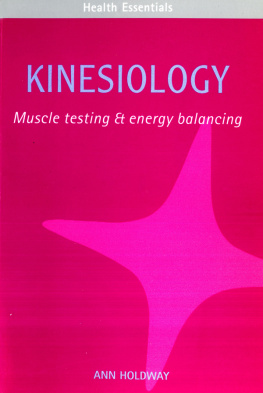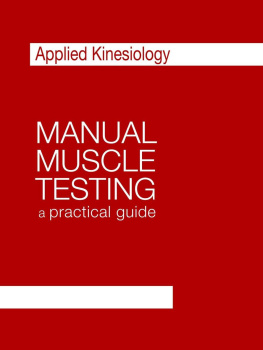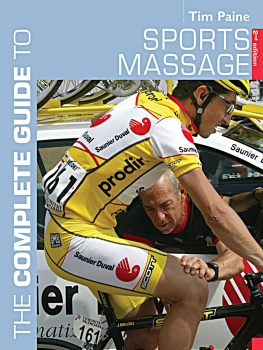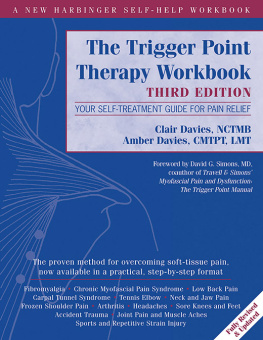
Muscle
Energy
Techniques
Muscle
Energy
Techniques
A Practical Guide for Physical Therapists
Second Edition
John Gibbons

Copyright 2011, 2013, 2022 by John Gibbons. All rights reserved. No portion of this book, except for brief reviews, may be reproduced, stored in a retrieval system, or transmitted in any form or by any meanselectronic, mechanical, photocopying, recording, or otherwisewithout the written permission of the publisher. For information, contact Lotus Publishing or North Atlantic Books.
First published in 2011. This second edition published in 2022 by
Lotus Publishing
Apple Tree Cottage, Inlands Road, Nutbourne, Chichester, PO18 8RJ and
North Atlantic Books
Berkeley, California
Drawings Amanda Williams
Photographs Ian Taylor
Text Design Medlar Publishing Solutions Pvt Ltd., India
Cover Design Chris Fulcher
Printed and Bound in India by Replika Press
Muscle Energy Techniques: A Practical Guide for Physical Therapists, Second Edition is sponsored and published by the Society for the Study of Native Arts and Sciences (dba North Atlantic Books), an educational nonprofit based in Berkeley, California, that collaborates with partners to develop cross-cultural perspectives; nurture holistic views of art, science, the humanities, and healing; and seed personal and global transformation by publishing work on the relationship of body, spirit, and nature.
North Atlantic Books publications are available through most bookstores. For further information, visit our website at www.northatlanticbooks.com or call 800-733-3000.
Medical Disclaimer: The following information is intended for general information purposes only. Individuals should always consult their health care provider before administering any suggestions made in this book. Any application of the material set forth in the following pages is at the readers discretion and is their sole responsibility.
British Library Cataloguing-in-Publication Data
A CIP record for this book is available from the British Library
ISBN 978 1 913088 32 3 (Lotus Publishing)
ISBN 978 1 62317 787 4 (North Atlantic Books)
The Library of Congress Cataloging-in-Publication Data
Names: Gibbons, John, 1968- author.
Title: Muscle energy techniques : a practical guide for physical therapists / John Gibbons.
Description: Second edition. | Chichester, England : Lotus Publishing ; Berkeley, California : North Atlantic Books, [2022] | Includes bibliographical references and index.
Identifiers: LCCN 2021057743 (print) | LCCN 2021057744 (ebook) | ISBN 9781913088323 (Lotus Publishing) | ISBN 9781623177874 (North Atlantic Books) | ISBN 9781623177881 (ebook)
Subjects: MESH: Manipulation, Orthopedic--methods | Muscles--physiology | Physical Therapy Modalities
Classification: LCC RM725 (print) | LCC RM725 (ebook) | NLM WB 535 | DDC 615.8/2--dc23/eng/20211130
LC record available at https://lccn.loc.gov/2021057743
LC ebook record available at https://lccn.loc.gov/2021057744
Contents
Introduction
In 2011, I published my first book, Muscle Energy Techniques , and exactly 10 years later after writing a further five, I have the opportunity to update the first book with this second edition.
Even after all these years of lecturing in the field of physical therapy, I still consider the techniques I will be demonstrating in this new edition to be some of the best soft tissue techniques that can be used to correct any soft tissue anomalies.
Physical therapists, for example: osteopaths, chiropractors, physiotherapists, and sports therapists have what I call a toolbox of various techniques at their disposal, to help release and relax muscles, which will then assist the patients body to promote the healing mechanisms. Muscle Energy Techniques (METs), first described by Fred Mitchell in 1948, are one such tool, which if used correctly can have a major influence on a patients well-being.
To emphasize their clinical significance, I generally use an MET, or a variation of one, with every patient I treat, and I feel it is a major component of the overall treatment plan. Without METs I would still have success with my patients symptoms, but when I incorporate an MET I feel that it is the icing on the cake in enabling my patients to experience a reduction of their symptoms.
I wanted to write a book so that the subject of METs could not only be easily understood by a student of physical therapy, but also be useful to the qualified practitioner. This new edition should appeal to anybody in the physical therapy field who would like to have easy access to METs without over-complicating the subject.
Even on my five-year osteopathy program, METs were a very small component of the course, and I was very disappointed with the way in which the subject was covered.
From that day, I vowed that I would write a very simple and straightforward book so that every studentwhether of osteopathy, chiropractic, physiotherapy, or sports massage therapywould be able to understand METs and, more importantly, be able to apply them without any concerns.
Acknowledgments
I would like to thank Jon Hutchings of Lotus Publishing for again allowing me the opportunity of following my passion for writing and especially with this second edition: I am truly grateful for his continual support and guidance.
I must thank Robert White of Physique Management, who is also my best friendwithout his involvement, the first book on muscle energy techniques would never have been published. I also want to say that Robert has been like a father figure to me over the years, as well as a good friend; he has helped me on numerous occasions to pursue my dream within my physical therapy careerthanks again.
Many thanks to Ian Taylor, the photographer for all my books to date. I appreciate all his extra work to make this second edition a success. Yet again he has done a fantastic job, especially with all the necessary, time-consuming editing of the photographs.
Thanks a million to Lee Thomas, who has been instrumental in the filming and editing of all the educational videos that are linked via QR codes in this book. You are a true professional in your field and for that I genuinely thank you.
I lost my father to cancer when I was only nine years old, and part of my drive to progress and be successful in my life is because I didnt have a father figure in my teenage years. I wanted to follow in my fathers footsteps and join the forces, so I enrolled in the army when I was sixteen years old. I still think of you every day, Dad, and I miss you so very much.
To my inspirational sister, Amanda WilliamsI want to thank you with all my heart for putting up with me when I was a troublesome teenager. This book is to demonstrate that, with determination and persistence, something can be achieved in a persons life even if they underachieve in school.
My thanks go to one of the models, Jack Meeks, of the University of Oxford Sports Department.
To Denise, my partnerthank you. Denise was the main model in the book and the greatest of supporters, allowing me the freedom to achieve my dreams.
Sadly, I have to mention my son, Thomas Rhys Gibbons, who is no longer with us. RIP my little boy every day is a struggle for me and when I see the shining star in the sky I think of you and it keeps me going. I will always be there for you in spirit and I love you so very muchyou will always be known as Tom-Tom to me.
Next page












